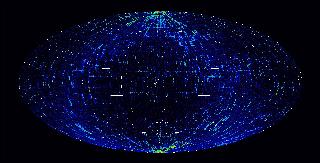
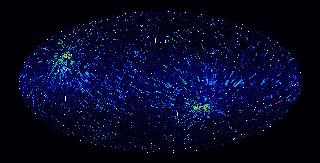
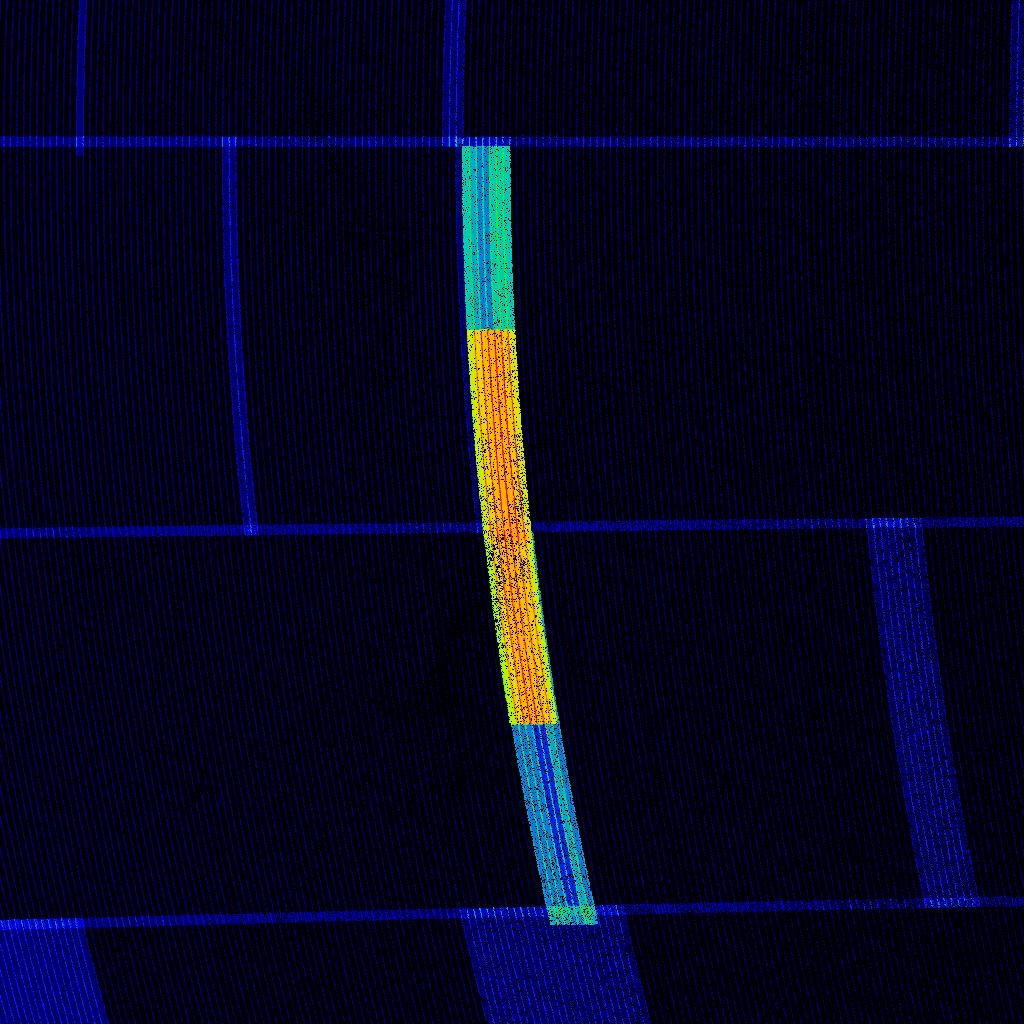
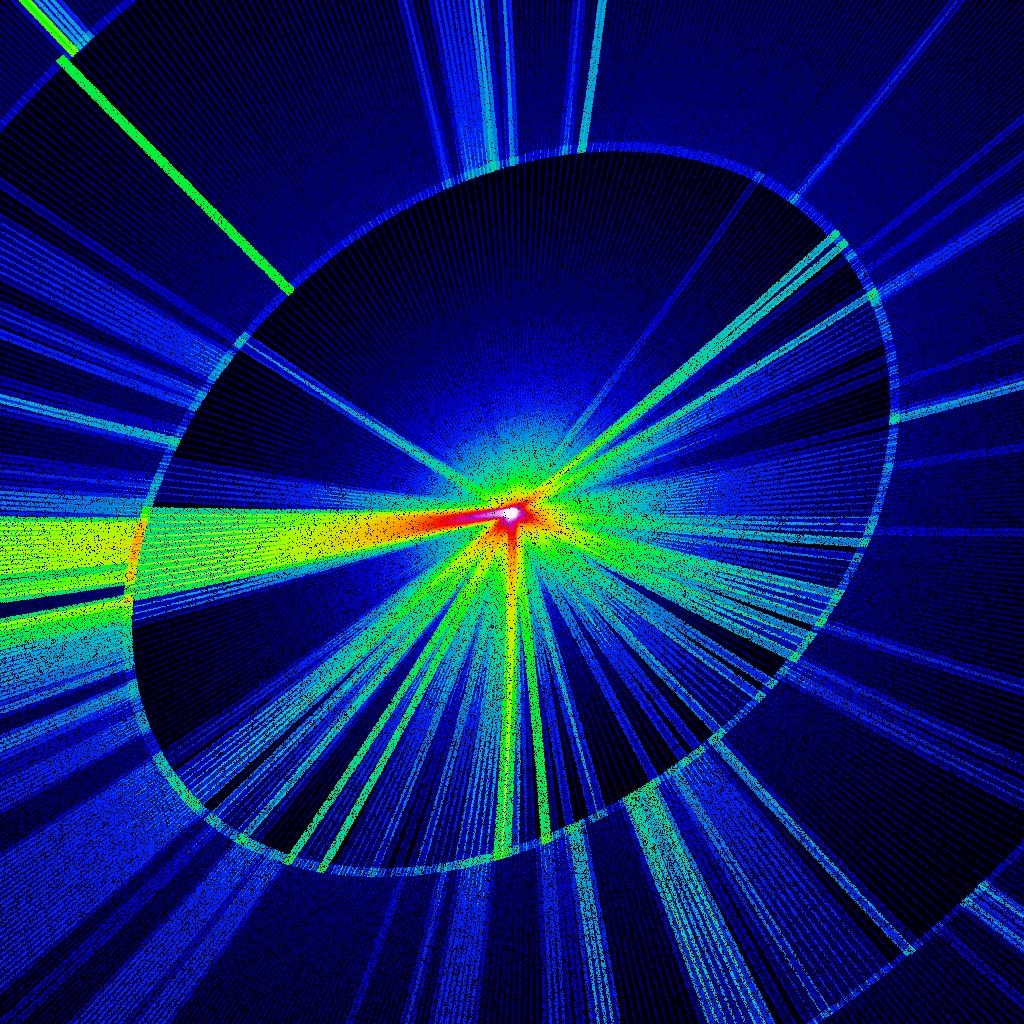
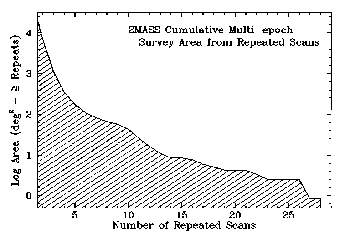
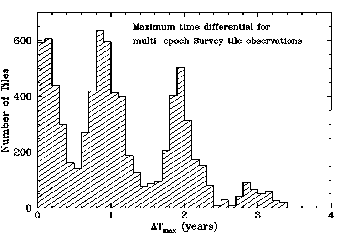
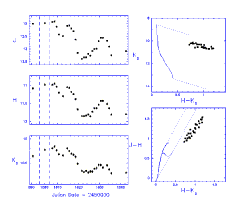
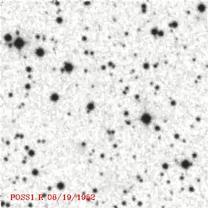
Between June 1997 and February 2001, the 2MASS observatories conducted 70,712 6°-long survey mode scans in photometric conditions that covered 99.998% of the sky. Pipeline data reduction of the raw survey imaging data yielded an Atlas containing 4,879,128 calibrated FITS images, Working Databases (WDBs) containing 1,314,981,867 point and 2,590,500 extended "source" extractions, and metadata tables describing the individual survey observations. The 2MASS All-Sky Release Point Source Catalog (PSC), Extended Source Catalog (XSC) and Image Atlas contain a subset of the entries in the Survey WDBs and Full Image Atlas that were selected from 59,731 of the survey scans to satisfy the Level 1 Science Requirements. The All-Sky Release Catalogs and Atlas are a heavily-scrutinized, single-epoch "snapshot" of the near infrared sky characterized by uniform sensitivity and high reliability.
The 2MASS Survey Point and Extended Source "Reject" Tables (PSRT and XSRT) contain the 843,988,897 point and 943,441 extended source measurements from the Survey WDBs that were not selected for inclusion in the All-Sky Release Catalogs. The characteristics of entries in the Reject Tables differs between scans that were and were not selected for inclusion in the All-Sky Release:
The number of entries in the Survey Point and Extended Source WDBs, All-Sky Release Catalogs and Survey "Reject" Tables are given in Table 1. The Full Survey WDBs are not released as separate tables; they are the combination of the respective All-Sky Catalogs and Reject Tables. The Full Survey Image Atlas and Scan Metadata Table are released as part of the Extended Mission because the Survey Reject Tables contain extractions from all survey scans.
The 2MASS survey observing facilities, strategy and data acquisition are described in Section III of the All-Sky Release Explanatory Supplement. Survey data reduction and calibration was performed using the 2MASS Production Processing System (2MAPPS) as described in detail in Section IV. The general properties of the Survey PSRT and XSRT and Full Image Atlas are described in A2.2. Survey Reject Table and meta-data table formats are described in A2.3.
Users are strongly encouraged to read the
Cautionary Notes on the
2MASS Survey Reject Tables and Full Image Atlas before
using these products. The Reject Tables are
fundamentally different from and should not be used in the
same was as the highly uniform and reliable All-Sky Catalogs.
For example, nearly 60% of the Survey PSRT entries and 20% of
Survey XSRT are unreliable extractions of noise and image artifacts,
and non-extended sources in the case of the XSRT.
| Full Survey Working Database | All-Sky Catalogs | Survey "Reject" Tables | |
|---|---|---|---|
| Point Source Extractions | [1,314,981,867]1 | 470,992,970 | 843,988,897 |
| Extended Source Extractions | [2,590,500]1 | 1,647,5992 | 943,441 |
| Atlas Images | 4,879,128 | 4,121,439 | --- |
| Scans | 70,712 | 59,731 | --- |
Although 2MASS was primarily a single-epoch survey, approximately 30% of the sky was observed more than once. Roughly half of this area is contained in 8,238 tiles that were scanned multiple times during the survey to obtain measurements under improved atmospheric conditions, or for validation purposes. The remaining multi-coverage area falls in the right ascension and declination overlap regions between tiles. Sources extracted from only one scan of each survey tile were used to construct the All-Sky Release Catalogs, and only one, unique measurement of multiply-detected objects in the overlap regions between tiles was selected to maintain the uniformity of the survey. The Survey Reject Tables contain all of the independent measurements of multiply-detected sources that were not selected for the All-Sky Release Catalogs. For example, the Survey PSRT contains one or more independent measurements of 150,569,237 point sources found in the All-Sky PSC. The Survey XSRT contains one or more independent measurements for 349,184 extended sources found in the All-Sky XSC.
Figures 1 and 2 show color-coded survey depth-of-coverage maps in equatorial and galactic projections, respectively. At the resolution of these maps, repeatedly scanned tiles are most easily seen. Tiles with two or more coverages appear in colors ranging from light blue to red. In addition to the equatorial poles, three regions of special interest were scanned repeatedly during the survey: the Orion and Chameleon I molecular clouds (25-28 epochs over ~5deg2 and 12-14 epochs over 4.5 deg2, respectively), and the Abell 3558 galaxy cluster (12-17 epochs over ~4 deg2). Figures 3 and 4 show close-ups of the coverage maps centered on Orion and the southern equatorial pole. At this scale, the tile RA and declination overlaps can be seen better, as can the very deep coverage at the poles that results from the convergence of tiles. Additional coverage of the circumpolar tiles also occurred because they were always observed at large zenith angles, and it was often necessary to observe them multiple times to obtain measurements under atmospheric background and airglow conditions that satisfied the survey's sensitivity requirements. Within ~3' of each pole, there are up to over 600 independent source measurements available in the Survey Reject Tables and Full Survey Image Atlas.
Figure 5 shows the cumulative area of sky plotted as a function of the number of independent observations from repeated survey tile scans only (no tile overlaps included). The most frequently visited tile was observed 28 times and covers the core of the Orion Molecular cloud. The distribution of times separating the first and last observations of all multiply-observed 2MASS survey tiles is shown in Figure 6. There are 5,692 tiles covering ~4,800 deg2 that were observed two or more times during the survey with epoch differences of >6 months.
The multi-epoch epoch data contained in the Survey Reject Tables and Full Image Atlas enable 2MASS-based investigations in the time domain, such as studies of source variability and proper motion. For example, the J, H and Ks light curves of AO Ori are shown in Figure 7. AO Ori is one of 1235 variables stars found in the Orion Molecular Cloud by Carpenter et al. (2001, AJ, 121, 3160) using the Survey Point Source WDB multi-epoch data. Figure 8 illustrates the motion (1.32"/yr) of the nearby M2.5V star LHS 534 using images from the two epochs of the Palomar Observatory Sky Survey and the 2MASS All-Sky Atlas. This star was observed twice during the 2MASS survey, separated by approximately one year, and was easily recovered in a search for proper motion objects using the Survey PSC and PSRT by Kirpatrick et al. (2007 private communication).
The Survey Merged Point and Extended Source
Information Tables
are designed to help users take advantage of the
2MASS survey multi-epoch data. In those tables, multiple, independent
measurements of the same source from the Survey WDBs (Catalogs+Reject Tables)
are combined to
improve the photometric and astrometric accuracy of static sources, and
statistics on the observed flux and position distributions are computed to
help identify variable and moving sources.
Please read Appendix VI for a complete
description of the Merged Source tables and suggestions for their use.
 |
 |
| Figure 1 - Survey depth-of coverage map, equatorial projection. | Figure 2 - Survey depth-of coverage map, galactic projection. |
 |
 |
| Figure 3 - Depth-of-coverage map close-up of 17ox17o region centered on Orion (equatorial projection). | Figure 4 - Depth-of-coverage map close-up of 17ox17o region centered on the south equatorial pole (galactic projection). |
 |
 |
| Figure 5 - Cumulative area of sky plotted as a function of number of independent survey observations from repeated scans. | Figure 6 - Maximum time separating first and last observations of all survey tiles with repeated scans. |
 |
 |
| Figure 7 - (left) J, H and Ks light curves of a candidate pre-main sequence star in the Orion Molecular Cloud, and (right) its evolution in the color-color and color-magnitude plane (Carpenter et al. 2001). | Figure 8 - Animated gif image showing the proper motion of nearby M2.5 dwarf LHS 534. Individual images are from POSS-I red (equinox 08/20/1952), POSS-II red (equinox 08/06/1992), and 2MASS J-band (equinox 10/06/2000). This star was recovered in a proper motion survey using the 2MASS survey PSC and PSRT (Kirkpatrick 2007, private communication). |
i. Low SNR Extractions
Point source detection was made down to a threshold of SNR~~3.5 during pipeline processing of 2MASS survey data. To meet the Catalogs' strict reliability requirements, sources were required to have SNR>7 in at least one detected band to have been included in the All-Sky Release PSC and XSC, or SNR>5 in three detected bands in the case of the PSC (V.3). Thus, the Reject Tables contain a large number of faint extractions that fall below the SNR thresholds used to define the Catalogs. These low SNR extractions are a combination of detections of real astrophysical sources and unreliable extractions of noise excursions.
The impact of unreliable, low SNR point source extractions is illustrated in Figure 9 which shows 2MASS Survey PSWDB differential Ks-band counts in the north galactic cap plotted as a function of brightness and SNR. The three panels in Figure 9 show, counterclockwise starting from the upper left: a) the differential count curves (dlogN/dM); b) photometric measurement uncertainty plotted versus the default magnitude; and c) count histograms as a function of photometric uncertainty. The horizontal green lines in the bottom two panels indicate the equivalent SNR=10, 7, and 3 levels. Also shown in the figure are the distribution of sources detected in more than one band (red curves) and of the sources that are positionally associated with optical counterparts in the Tycho 2 or USNO-A2.0 Catalog (blue curves, IV.4f), two proxies for source reliability at high galactic latitudes.
The distributions of multi-band extractions and those with optical counterparts demonstrate that there are many reliable source detections below the Catalog thresholds. However, the fraction of reliable extractions in the full WDB drops dramatically below SNR~7. To assist in the navigation of the low SNR populations that comprise much of the Reject Tables, each entry has been assigned a reliability score (rel), based on SNR and other source quality indicators, that is related to the probability that the extraction is a detection of a real source at the time of the 2MASS observation.
Another way to select reliable source detections among the low SNR constituents of the 2MASS Survey Reject Tables is via cross-correlation with reliable external catalogs having good astrometry. For example, Gregg et al. (2002, ApJ, 564, 133) and Glikman et al. (2004, 607, 60) found a number of very red quasars among FIRST radio sources that have faint 2MASS All-Sky PSC counterparts, but no visible counterparts on the Sky Survey Schmidt plates. The objects may be highly reddened active galactic nuclei, possibly viewed through obscuring circumnuclear tori. Figure 10 shows histograms of radial separations between positions of FIRST radio sources in the north galactic cap and a) all 2MASS Survey Point Source WDB extractions within 5" (black curve), b) point source extractions that meet the SNR thresholds used to define the PSC (red curve), and c) the difference between the two (blue curve). The peak at separations <2" for the low SNR sources shows that there are ~1000 real associations between FIRST radio sources and faint 2MASS sources in just ~300 deg2 that will be a rich new population in which to search for rare obscured quasars.
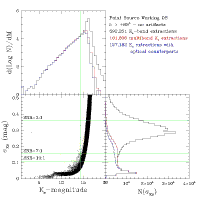 |
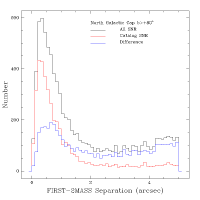 |
| Figure 9 - Differential Ks "source" counts and SNR distributions for Survey Point Source WDB extractions in the north galactic cap. The red and blue curves show the distribution of reliable extractions. | Figure 10 - Radial separation distributions between FIRST radio sources and 2MASS Survey Point Source WDB extractions in the north galactic cap. The blue curve represents WDB extractions fainter than the SNR limits used for the PSC. |
ii. Other Spurious Extractions
The 2MASS Survey Reject Tables contain a number of other spurious extractions that are not detections of real sources on the sky, or in the case of the XSRT, not truly extended objects. Many of these unreliable extractions were identified and flagged during pipeline data processing and follow-up validation, and were filtered out of the All-Sky Release Catalogs to insure their reliability. However, flagged and unflagged artifacts remain in Survey Reject Tables. Users are urged to use the source quality indicators that are provided with each Reject Table entry (c.f. A2.1.b.ii and A2.1.c.iii).
Spurious extractions known to be present in the Survey Point and Extended Source Reject Tables include:
iii. Why Release the Unreliable Extractions in the Reject Tables?
It is reasonable to ask why are extractions known to be spurious being released with the Survey Reject Tables (as well as with the 6x and Calibration Scan WDBs). They have been included in the Extended Mission products for the following reasons.
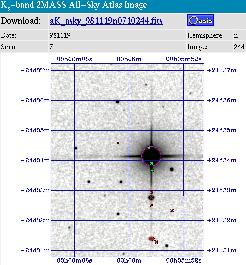 |
| Figure 11 - IRSA/2MASS Interactive Image Service result page showing a Ks image containing the star HD100. The red and green crosses marking the location of latent image and dichroic glints, artifacts that can be mistaken for real sources, are generated from the flagged artifacts in the survey point source Reject Table. |
[Last Updated: 2007 January 2; by R. Cutri]